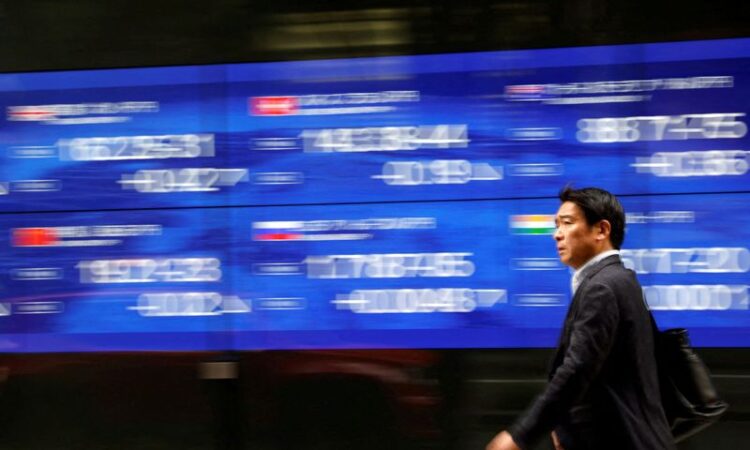
By Tom Westbrook
SINGAPORE (Reuters) – Asian shares wobbled in cautious trade on Tuesday, while the dollar was firm ahead of a series of data releases and central bank meetings that begins with the Reserve Bank of Australia later in the day.
The overnight sale of First Republic Bank’s assets to JPMorgan Chase resolved the third U.S. bank failure in two months. Treasury yields rose in response and expectations firmed to near certain for one final U.S. rate hike this week.
JPMorgan shares rose 2.1%. The S&P 500 closed flat and ANZ analysts said markets’ relief was evident.
MSCI’s broadest index of Asia-Pacific shares outside Japan wriggled either side of flat, and was last down 0.2% after tech and casino gains in Hong Kong proved shortlived.
Mainland China markets were closed. Japan’s Nikkei hit a 16-month high, before backing off slightly, with the bank sector a drag. [.T]
Hundreds of thousands of Chinese visitors hit Macau’s casinos last weekend for the Labour Day holiday, and overnight MGM Resorts international reported better-than-expected revenues and called out strong volumes in Las Vegas and Macau.
The yen, meanwhile, steadied after two sessions of heavy falls following the Bank of Japan’s decision on Friday to stick with ultra-easy monetary policy for the time being. [FRX/]
The policy stands in contrast to the U.S. and Europe where central banks are deep into a hiking cycle and still going.
The yen fell through its 200-day moving average on Tuesday and hit an almost two-month low on the dollar early on Wednesday before steadying at 137.40.
The Japanese currency made a fresh 14-1/2 trough at 151.08 per euro on Wednesday and is trading at its lowest recorded on the Swiss franc in Refinitiv data stretching back to the early 1980s. The euro held at $1.0987.
‘UNPREDICTABLE’
Much of Europe also returns from May Day holidays on Tuesday, with final activity surveys due, preliminary inflation figures and a survey of European bank lending that will be closely watched given recent stresses in the sector.
European futures rose 0.1% in Asia, while S&P 500 futures fell 0.1%.
On the monetary policy front the Reserve Bank of Australia (RBA) is first up in a week that brings central bank meetings in the U.S., Europe and Norway. Markets are positioned for the RBA to stand pat and the others to hike.
“(The Aussie dollar) can rise by 0.8% if the RBA lifts the cash rate by 25 bp as we expect, because financial markets are pricing almost no chance of a change,” said Kristina Clifton of the Commonwealth Bank of Australia in Sydney.
Interest-rate futures trade implies a 95% chance of a 25 bp hike from the Federal Reserve on Wednesday, but markets are also pricing rate cuts by year’s end.
Two-year Treasury yields, which track short-term U.S. rate expectations were steady at 4.1221% in Asia. U.S. credit default swaps – which reflect insurance against a default – are illiquid but have surged lately as political brinkmanship pushes the U.S. government near its borrowing limit.
Overnight, Treasury Secretary Janet Yellen said the Treasury might run out of money to cover obligations as soon as June 1.
“The next few weeks are going to be unpredictable,” Goldman Sachs analysts said in a note,” with uncertainty over the precise deadline not helping to focus lawmakers’ minds.
“That could raise the risk that Congress does not lift the debt limit in time, which could result in missed payments but could also result in a short-term extension, in which case the exercise would repeat a few weeks or a few months later.”
(Editing by Shri Navaratnam)






